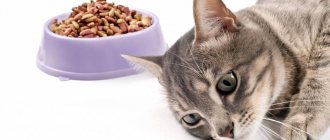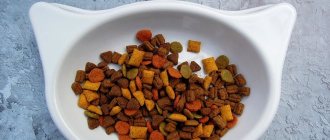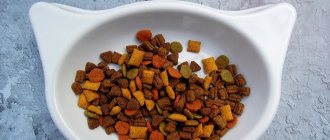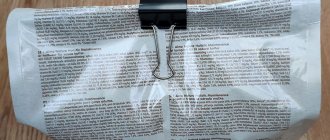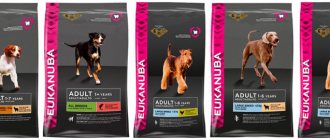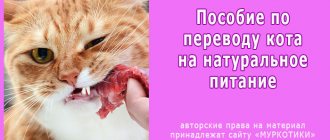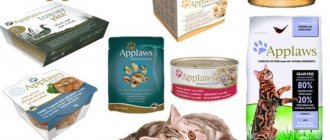Choosing a dry diet as the main food for dogs is a convenient, practical and affordable option that will simplify the life of the owner and maintain the health of the pet. It would seem that everything is simple, you just need to read on the packaging how much food to give your dog, measure out the required amount of dry granules and pour them into a bowl. In reality, many problems and questions arise. From the article you will learn: how the daily intake depends on the energy value and class of food, what to do if the dog does not eat enough of the recommended portion, how much water is needed and when it is necessary to review the amount of food given to the dog.
Should you feed your dog only prepared food or use a mixed diet?
Before we find out exactly what portion of dry food a dog needs every day, let’s find out whether it is possible to feed the dog exclusively with dry granules or canned food. Many owners worry that such a diet is too monotonous and can lead to negative consequences. To avoid this, they switch the pet to a mixed diet - mixing meat directly into a bowl of dry granules or replacing one of the meals with natural products.
Let's highlight the main risks that a dog's mixed diet carries:
- the combination of dry food and meat products can lead to excess protein. Its excess puts additional stress on the kidneys and liver. The result is kidney failure, liver dystrophy, allergic reactions;
- the combination of dry pellets and fish leads to an excess of phosphorus. The result may be urolithiasis. In addition, there is a critical decrease in the level of leukocytes. Minor hemorrhages appear. Bones lose calcium and accumulate phosphates. In adults this leads to osteoporosis, in children to rickets;
- a mix of dry food and porridge leads to an excess of carbohydrates in the body. This situation threatens the rapid development of obesity and all the ensuing consequences.
Constant menu changes actually terrorize the gastrointestinal tract, forcing it to produce different types of enzymes. Such intense work leads to gastritis and peptic ulcers.
Opponents of dry food talk about the risks that a monoration poses. First of all, they note a negative effect on the mucous membranes, especially when the daily norm is exceeded. Despite the qualitative differences in dry diets depending on the class to which they belong, there is no negative effect on the mucous membranes. Before entering the market, all dry food undergoes laboratory testing. All of them are produced with a monoration in mind, so high-quality products contain the entire necessary set of minerals, vitamins and microelements.
Important: of course, it is worth considering the presence of diseases in your pet. Particular attention should be paid to gastrointestinal problems. If a veterinarian recommends giving up dry food and switching to a natural diet, this must be done.
Why do you need to define the norm?
Determining the daily feeding rate is very important. Overfeeding or underfeeding will lead to health problems. Dogs cannot control their food intake on their own. Some breeds, such as pugs or dachshunds, will eat whatever is in their bowl. This behavior has a genetic reason - in nature, the ancestors of dogs did not get prey every day. Of course, domestic dogs are freed from the need to get their own food, but unlimited access to dry food leads to excessive consumption.
Interesting: some manufacturers put a special measuring cup in the package with dry food, which is very convenient for measuring portions for your pet. It is worth remembering that such measuring containers are only suitable for granules from a certain manufacturer and cannot be used for others.
Veterinarian advice
How do you know if you are feeding your four-legged friend correctly? The puppy should look lean, that is, you can feel the costal arches through a small subcutaneous layer of fat, its muscles are developed, and its chest is slightly wider than its waist. Without going into details, a healthy puppy looks plump, slightly plump, but not at all fat.
The baby's development may slow down during illness, but will quickly recover after recovery. There is no need to overfeed the puppy at this time. Excessive load on the dog's skeleton can cause osteochondrosis or joint dysplasia. Pay attention to the amount of calcium your pet receives. A deficiency is just as harmful as an excess.
It is very important to adhere to the initially chosen feeding strategy. If you feed your dog natural products, do not introduce ready-made food into the diet, even as an exception. And vice versa: a dog that eats exclusively industrial food will have difficulty digesting human food.
How often do you need to care for your dog’s ears, and what lotions, drops and other products are used at home?
And a little about food culture. The dog’s bowl should be located on a hill so that the dog’s musculoskeletal system can develop correctly. If within 15 minutes from the start of feeding the puppy has not eaten the entire portion, feel free to remove the bowl until the next meal. Are you sure that your pet is getting enough to eat, but despite this, he is constantly begging for food from the owner’s table? Stop such attempts immediately! It’s one thing for a funny puppy whining near its owners, and quite another thing for an adult dog to climb its paws onto the table and leave greasy marks on the tablecloth.
How to calculate the amount of food for a pet
Since we are talking about ready-made food rations: dry and wet, we will need to take as a basis tables with recommended daily intakes placed by manufacturers on food packaging. However, the owner will have to take into account a number of individual factors that distinguish his dog. These include:
- Age category of the dog (puppy, young or elderly dog);
- Weight (can be normal, overweight or underweight);
- Dog activity (number and duration of walks, physical activity during the day);
- State of health (presence of chronic diseases, pathologies);
- Physiological condition (pregnancy, lactating bitch, recovery from illness or surgery, and others).
The tables from the manufacturer indicate the recommended daily intake of dry food. Quite often they are significantly overestimated; manufacturers are simply not able to take into account all the characteristics of your pet.
It is necessary to collect all individual information about the dog and determine the brand of food for which the calculation will be made. It is better if dry food is selected by the owner together with a veterinarian, since it is not always possible to independently take into account all the medical contraindications of the animal. The use of a dry diet can lead to serious kidney problems and a serious allergic reaction - advice from a specialist in selecting food and determining the portion size is simply necessary.
Selecting one manufacturer
The most common mistake dog breeders make when choosing food is changing manufacturers or brands. If you constantly use one type of food when feeding a dog, it begins to produce gastric juice of a certain composition.
How often can you wash your dog at home and how to properly bathe your pet after a walk
Food from different manufacturers, and even within the same brand, may differ in the content of substances, so switching to another type can provoke disturbances in the functioning of the stomach and intestines. While the digestive system adapts to the new composition of the feed, nutrients are not fully absorbed.
Types of dog food
One of the most important indicators of dry food is its relationship to a certain class and the energy value of such a diet. There are types of dry food:
| View | Energy value (Kcal/100 g) | Compound | Recommendations | Example |
| Economy | 250-300 | Poor composition, based on grains and corn. Contains aromatic additives and dyes. A large portion is needed to satiate the dog. | Should not be used for regular feeding of dogs. Requires the use of additional vitamin and mineral complexes. | Chappie, Oscar, Meal, Favorite, Our brand, ProTail, Darling, Pedigree. |
| Premium | 300-350 | Higher protein content (about 20%), mainly due to offal and meat production waste. The composition contains vitamins and minerals, fiber. | Suitable for everyday nutrition, requires vitamin supplements adjusted for the physiological state of the dog. | Royal Canin, Brit Premium, Monge, |
| Super premium | 360-450 | The most balanced diet, with a minimum content or complete replacement of grains, a maximum content of meat (up to 75%). A complete complex of vitamins and minerals. | Suitable for daily feeding of dogs, no additional feeding is needed. | Akana, Eukanuba, Grandorf. |
| Holistic | 360-450 | Difference from the super premium class: the ingredients that make up the food are approved for use in the human food industry. | Maximum benefits, recommended for use in dog nutrition. | Landor, G.O., Canidae, Grandin. |
The daily amount is indicated by the manufacturer based on the normal physiological weight of the animal, and not the actual weight. If your dog weighs much more than is expected for a certain age, this is a reason to contact the veterinarian.
There is no direct relationship between the amount of dry kibble in your pet's bowl and how quickly he becomes satiated. A dog can eat a “bucket” of economy class pellets and remain hungry. Don’t think that buying low-grade food will save you money.
Feeding chart by dog weight
To independently calculate the daily amount of dry formula required for your pet, it is convenient to use a table that indicates the required amount of the product. In this case, you need to know the energy value of a particular feed.
Royal Canin
The product belongs to the super premium category and is of high quality. The mixture contains all the ingredients, vitamins and microelements required by the animal. The manufacturer offers food for all breeds of dogs, as well as for puppies, nursing bitches, old and sick pets. Royal Canin formulations should be given to the animal in strictly limited quantities. To calculate the feeding rate, use this table:
| Dog weight | Serving (g) |
| About 2 kg | 40-50 |
| 2-3 | 55-65 |
| 3-4 | 70-80 |
| 4-5 | 80-95 |
| 5-6 | 90-105 |
| 6-7 | 100-120 |
| 8 | 115-130 |
| 9 | 116-120 |
| 10 | 126-130 |
Chappie
Dry mixtures are produced by an American company. A distinctive feature of the product is its composition: Chappie contains brewer's yeast, which improves the pet's immunity. The rate of consumption of economy class mixture will depend on age, weight, lifestyle, and breed of animal. The average daily dosage can be calculated using the table provided.
| Dog weight (kg) | Daily serving (g) |
| To 10 | About 180 |
| 10-20 | Up to 350 |
| 30-40 | Up to 500 |
| 40-60 | 650 |
Brit
The company produces premium dry mixtures for different breeds, ages and sizes of dogs. It won’t be difficult to choose the right product, and to calculate the optimal daily portion, you can use the following table offered by the manufacturer:
| Animal weight (kg) | Daily feeding dosage (g) |
| To 10 | 120 |
| 10-20 | Up to 200 |
| 20-30 | Up to 270 |
| 30-40 | 330 |
Dog Chow
The product contains minerals, vitamins, oils and fats. About a quarter of the mass comes from whole grains and antioxidants, and about 15% is the meat component. Dog Chow is a high-quality, balanced premium dry product that is suitable for all breeds:
| Weight (kg) | Daily Amount (g) |
| 13-15 | 100-200 |
| 15-25 | 200-350 |
| 25-40 | 300-600 |
| 40-70 | 500-800 |
Dry food
There are average feeding rates, according to which the daily dose is divided by the number of feedings. Most often, this standard is indicated in grams or in the number of measuring cups. 1 measuring cup = 240 ml (about 100 grams).
If necessary, dry granules can be softened with liquid: for puppies under 4 months of age, for older dogs or those with gastrointestinal problems.
I do this with different liquids depending on the dog’s preferences.
You should not prepare a large portion of soaked food, so as not to throw away an expensive product. Experts note that in the warm season, many animals refuse the softened product, preferring to drink dry granules with water.
Is it possible to combine drying and natural?
It is not recommended to feed your dog dry food and natural food at the same time, because the intestines will digest different types of food differently. In addition, the dog may subsequently refuse to eat the dry food. Mixing diets is possible in some cases:
Feeding puppies in nurseries. Breeders accustom babies to both types of food, so that in the future they can more easily adapt to what the owner chooses.
Sports dogs and hunting breeds. They need an increased amount of protein, but no more than 30% of the norm. The source can be meat, eggs or cottage cheese.
Breeding males and females. To obtain more nutrients, you can add herbs, meat, cottage cheese, and vegetables to the concentrate.
When combining, remember that you cannot give both types of food together.
It is better to divide it into several doses: dry food in the morning, and natural food in the evening. Warning! The concept of “natural food” should not be confused with human food. For natural nutrition, only fresh or boiled meat, fish, vegetables, fruits and dairy products are used.
Rules for soaking dry food
If for some reason the amount of dry food is soaked, it is recommended to adhere to the following rules:
- use clean drinking water (can be bottled or filtered), but not boiled. Temperature - 40°C;
- The ratio of liquid to dry product depends on the preferences and age of the dog, and the manufacturer’s recommendations. Possible ratios (water:feed) - 1:2, 1:3;
- In addition to water, you can use low-fat fermented milk products - yogurt or kefir. The diluent should not be sweet, the temperature should be room temperature;
- the daily feed intake is not increased or decreased. Only the consistency of the portion changes.
Important: soaked dry food should be eaten within 2-3 hours. At any temperature, such food quickly sours and is inseminated by bacterial flora. If fermented milk products are used, it is necessary to carefully monitor the animal's stool. Minor liquefaction that resolves quickly should not cause alarm. If diarrhea continues for a long time, it is necessary to stop soaking dry food and consult a veterinarian.
The manufacturer may set a limit on the soaking of dry granules, which should be noted on the food packaging.
Photo: pixabay.com
What affects the amount of feed?
First of all, the amount of dry dog food depends on the characteristics of the animal itself. Equally important is the caloric content of the feed and its saturation with fiber, fats and carbohydrates, as well as other nutrients. Here's what you should pay attention to when calculating the amount of food for your pet.
- Age
Puppies should be fed more often and in small portions, adult dogs - less often, but the portion size should be larger.
- Weight
The amount of dog food varies based on this indicator: the more the pet weighs, the larger the portion it needs for satiety and energy.
- Size
Large and small dogs need different amounts of food, so their feeding standards are different.
- Breed
Great Dane dogs, for example, need ten times more food than a Chihuahua.
- Mobility
The amount of food consumed increases in dogs that lead a very active lifestyle. When running, playing and hunting, a pet spends a lot of energy and needs to replenish it through food.
- Health status
The serving size and frequency of feeding dogs dry food may vary depending on the health of the pet. A sick pet may need more nutrients for speedy recovery and recovery.
- Calorie content of feed
The caloric content is indicated on each package - usually the number of calories is indicated per 100 grams or kilograms of the product. Thus, the portion of high-calorie food must be precisely adjusted so that the pet does not overeat, and low-calorie food so that it can be properly satisfied.
Wet food
Soft canned food has exactly the same division into classes as dry food. This means that the higher the class of food, the greater its energy and nutritional value, which means that less of it will be needed to saturate.
However, it is not recommended to completely switch the animal to feeding canned foods - soft food can cause problems with the gastrointestinal tract, constipation or loose stools, and the risk of tartar formation increases, since there is no mechanical cleaning of plaque.
| Type of dog | Daily calorie requirement (kcal) | Combined diet (dry + wet) (g) Pedigree | Only wet (100%) (gr) Using Pedigri as an example |
| Miniature (2-5 kg) | 250-350 | 40-50 | 300-400 |
| Small (6-10 kg) | 360-550 | 50-100 | 400-700 |
| Medium (12-24 kg) | 600-1050 | 100-250 | 800-1300 |
| Large (26-40 kg) | 1100-1550 | 200-300 | 1400-2000 |
| Very large (45+ kg) | 1600-2500 | 300-550 | 2050-6000 |
How to use a food measuring cup?
place the glass on the scales and turn them on (so that together with the glass they show “0.00”); Gradually fill the container with dry granules, monitoring the numbers on the scales; As soon as you reach the desired level, shake the glass slightly and adjust it to the level of the food
horizontal mark with a marker.
Interesting materials:
How can I order a social taxi? How can I make an appointment with bailiffs? How can I register on the government services website? How did a husband cut off his wife's hands? How to open all tabs on iPhone? How to put a voice recorder recording on repeat on an iPhone? How to change the date on a Tissot watch? How to reach an operator on Kyivstar? How did the February Revolution begin? How did the new era begin?
Daily food intake for puppies
| Puppy age (in months) | Number of meals per day | Daily kcal norm per 1 kg of weight in |
| Up to 1 | 6 | 220-250 |
| 1-3 | 5 | 260-280 |
| 3-4 | 4 | 200-230 |
| 4-8 | 3-4 | 120-150 |
| 8-12 | 2-3 | 100-130 |
Small breeds of puppies
Puppies of small and miniature breeds develop very quickly due to increased metabolism; at 6 months, such a miniature dog puppy is already very similar to an adult dog. Therefore, during the period of intensive growth, such babies need high-calorie food, which allows the animal’s body to properly form in such a short time.
| Age\weight (months) dog weight up to 10 kg | Super premium diet (using Akana as an example, value about 450 kcal) | Economy (using the example of Our Brand, value about 300 kcal) |
| 1-3 | 15-80 gr | 45-100 gr |
| 3-4 | 17-115 g | 60-200 gr |
| 4-6 | 20-120 gr | 70-250 gr |
| 6-12 | 25-125 gr | Feed used for adult animals |
Photo: flickr.com
Large breeds of puppies
Large breed dog puppies need a diet rich in protein and calcium for muscle growth and healthy skeletal development. Their development occurs spasmodically, at six months of age they look more like ugly ducklings rather than adult dogs. The heart muscle also requires special nutrition, which must receive all the necessary elements for further uninterrupted operation.
| Dog's age/weight | Super premium diet, value 400 kcal (using Grandorf as an example) | Economy food, value 300 kcal (using the example of Pedigree) |
| 1-3 (from 5 to 70 kg) | 50-220 gr | 400 gr |
| 3-4 (from 25 to 70 kg) | 230-330 gr | 450-530 gr |
| 4-6 (from 25 to 70 kg) | 260-500 gr | 550-600 gr |
| 6-12 (from 25 kg) | 250-800 gr | 650-900 gr |
Recommended feeding rates
The daily amount of dog food is calculated based on several factors:
- pet's weight;
- age;
- activity;
- tendency to gain excess weight.
How to lose weight for a dog: food and diet for obesity
These indicators are the most important when creating a dog’s diet.
Important! You need to understand that large dogs, such as a husky or a Labrador, will need more food than a Pomeranian.
However, there are some other points to consider:
- presence of pregnancy;
- growth rate (varies among different breeds);
- the presence of diseases or the duration of the recovery period;
- living conditions (animals living outside require more nutrients, especially in winter).
Note! When preparing a diet, you can also consult a veterinarian.
In general, the average daily intake of dry food for adult animals, depending on weight and physical activity, can range from 200 to 900 g per day. In this case, the dog needs to be fed 2 times a day.
Do not exceed the amount of dry food to avoid overeating
For service dogs and athletes, it may be necessary to increase the portion by ⅓ of the total dosage; for pregnant bitches, the amount of food is increased by a quarter. For older dogs, on the contrary, the portion should be reduced by ⅓.
Puppies are fed much more often. At the age of up to 2 months, the frequency is 5-6 times a day, at 3 months - 4-5 times. At the age of 4 months to six months, 3-4 feedings are sufficient. From 6 months to a year, food is given three times a day; after a year, the dog is already an adult, and the frequency of feeding should be appropriate.
Many owners often have a question about how many grams of food per day should be given to the puppy. The amount of food for babies depends on the breed and weight. For small dogs, the portion will be smaller than for puppies of larger breeds. To correctly calculate the amount of food for babies, you will need to know their weight and calorie content of food. Approximate data per 1 kg of weight can be seen in the table below.
| Age | Calorie content (kcal per 100 g) |
| Up to 1 month | 220 |
| Up to 3 months | 270 |
| Up to six months | 150 |
| Up to a year | 120 |
Note! For very young puppies, dry food should be soaked a little in water to avoid damage to the teeth.
On each food package, the manufacturer indicates the recommended amount for the dog depending on its weight. However, you cannot be completely guided by these parameters, because each dog is individual.
The norm for puppies also depends on the weight and age of the baby
Daily food intake for adult dogs
| Normal dog weight (kg) | Norm of dry granules per day (g) with normal activity | Norm for high animal activity (in g) |
| 1.5-6 | 50-110 | 100-200 |
| 6-10 | 115-150 | 215-290 |
| 10-16 | 155-230 | 300-410 |
| 16-23 | 235-290 | 420-550 |
| 23-35 | 295-400 | 560-630 |
| 36-45 | 410-500 | 700-900 |
| 45+ | 510 + 50 g/ 5 kg weight | 800 + 100 g\ 5 kg weight |
For a pregnant bitch, the daily intake of an adult dog (by weight) is increased by 25-50% depending on appetite, in consultation with a veterinarian. It may be worth giving up food intended for adult dogs and using a diet for puppies. A portion of such food is calculated according to the rule: the daily norm of an adult healthy individual with normal activity + 25-50%.
Effect of feed classes
There are economy, premium and super premium food. The last category of ready-made food contains meat, vegetables, and fully meets the nutritional needs of cats. They produce food that takes into account age, gender, and dietary food for sterilized cats and pets of all ages, from kittens to older adults. Economy class meals do not have a wide range of options.
The class of feed has little effect on palatability. Pet owners may find that their pets' output increases and their odor increases when switching to a frugal diet. The coat does not shine, the animal may gain excess weight. An unbalanced diet has a negative impact on the liver and kidneys; the pet ages faster and develops chronic diseases.
Be sure to read:
Super premium food is high in calories, so cats need less kibble to fill them up. So, for an adult pet weighing 4 kg, Royal Canin manufacturers recommend giving 55 g per day; manufacturers Kitiket 63.
Daily food intake for older dogs
Upon reaching the age of seven, the pet needs to review its diet and the amount of food consumed. During this period, chronic diseases and pathologies worsen, and metabolism slows down. The dog needs additional minerals, but not an increase in food portions. It is worth changing the food, choosing one that contains special markings.
Let us note that with age, most animals’ need for rest and sleep increases, but food preferences change greatly: from uncontrolled food consumption to refusal of it.
If your dog has problems with the gastrointestinal tract or teeth, you should start soaking the granules or switch to wet canned food.
| Dog weight (over 7 years old) in kg | Daily value (in g) | Daily value in a cup (1 measuring cup about 100 g) |
| 1,5-5.5 | 35-100 | 1\3-1 |
| 5,5-9,5 | 110-150 | 1-1,5 |
| 10-15 | 160-210 | 1,5-2 |
| 16-23 | 220-300 | 2-3 |
| 24-35 | 310-380 | 3-3,5 |
| 36-45 | 390-470 | 4-4,7 |
| 45+ | 480 + 50 g/ 5 kg | 5+ |
Is the range suitable for cats?
If a dog tries cat food, nothing bad will happen, especially if it belongs to the holistic or super-premium class. This is exactly the same quality food with a high meat content and vitamins. Despite this, you cannot constantly feed your dog this food and here’s why.
The high protein content and low fiber content of cat food can lead to problems with the dog’s digestion (constipation), as well as cause heart problems and obesity. In addition, these feeds have a high taurine content. Unlike cats, dogs successfully synthesize this acid, so its excess can cause heartburn and provoke exacerbations of gastritis.
It is strictly forbidden to give your dog cat food if the dog has:
- allergy to its components and especially protein;
- with visible signs of digestive upset (nausea, vomiting).
In addition, food intended for cats should not be left within the visibility of sick or elderly pets.
Different tastes Pro Plan
How much water does a dog need when eating dry food?
Water is the basis for proper digestion and metabolism. In order for your dog’s body to receive all the necessary substances from their dry food, you must strictly follow the rules for providing it with water:
- The daily water intake depends on the dog’s weight and the portion of dry food consumed;
- For 1 kg of animal weight, about 40-60 ml of water is required;
- Puppies need more fluid - about 80-100 ml per kg;
- Monitor your pet's behavior - if he eats exclusively dry food, he may need more water than normal;
- If the ambient temperature drops below +20, the dog can reduce its fluid intake.
A bowl of clean, fresh water should always be available to your dog. Monitor your fluid intake - deviations from normal behavior should alert you and this is a reason to consult a doctor. Don't get dehydrated!
Photo: wikimedia.org
The need for vitamins
Feeding your pet with dry complete food assumes that it contains all the necessary vitamins and minerals.
Therefore, the risk of vitamin deficiency with such a diet is reduced to zero. Additives need to be taken care of when using economy class food. In this case, you can add multivitamins sold in pet stores or specialty pharmacies. It is important not to overdo it with additives. An excess of any substance in the body can cause hypervitaminosis and even cause death.
Karmy
If the dog does not eat enough dry food
All these rather complex and sometimes inaccurate calculations are needed to ensure that the dog does not starve and receives the maximum amount of nutrients from the food it eats. Of course, if a dog is constantly begging for treats and food from the owner’s table, this does not mean that the portion of food is not enough for him. However, you should carefully ensure that the offered portion is enough. Symptoms of deficiency may include:
- after feeding, the dog does not leave the bowl, freezes, waiting for more;
- the dog’s ribs, pelvic bones and scapular edges are clearly visible;
- the hunger pit is pronounced;
- the fat layer is thin.
These signs indicate that the dog is underweight. This can be either a consequence of the disease or insufficient nutritional value of the daily diet. In this case, the owner must:
- Visit your veterinarian to rule out your pet losing weight as a result of illness. For example, infections with parasites;
- if the dog receives super premium or holistic food, it is worth increasing the portion. Perhaps the animal’s physical activity has increased, its physiological state has changed, the cold season has arrived - all these are reasons to increase the proportion of dry granules in the bowl;
- if feeding is carried out with a diet of a lower class, choose higher quality, high-calorie and energy-rich dry food. It is better to choose an option, buying it in small packages in order to choose exactly what your dog will like;
- You can switch your dog to a mixed diet according to the following scheme: wet canned food + dry granules. Canned food is more nutritious and is often more appealing to animals.
Nutrition rules for small dogs
A distinctive feature of such animals is accelerated metabolic processes. This is facilitated by their inherent activity, nervous excitability, strong heat loss and the volume of the liver in relation to the body.
Required dry food:
- consisting of small granules;
- high-calorie;
- easily digestible;
- balanced;
- full-featured;
- optimal calorie content (370–400 kcal per 100 g).
Feeding rules:
- portions should be small;
- scheduled meals;
- give food at approximately the same time every day;
- feed twice a day (optimal);
- do not feed regular food from the table;
- do not resort to fertilizing.
Why is underfeeding bad?
If exceeding the norm threatens obesity, then what is wrong with underfeeding? A deficiency of nutrients that the dog does not receive from the daily diet will have a bad effect on the dog’s health - the animal’s bones and internal organs will suffer. This is especially true for pregnant and lactating bitches. Underfeeding is dangerous for a puppy or a bitch that has just given birth.
During the period of feeding puppies, the feeding rate is increased - in this case, the food can be left in the animal’s bowl without restricting it. Even if she eats 200% of her daily allowance, that's okay. Malnutrition threatens not only the deterioration of the health of the mother with a tail, but also of the puppies, since the quality of milk decreases.
Important: if during the feeding period the bitch cannot eat a lot of food, and she loses weight, it is worth consulting a specialist. It would be better to switch the animal to a higher-calorie type of dry food.
If my pet won't eat dry kibble, can I soak it in water?
- It is best to consult with your veterinarian, he will answer all your questions, taking into account the characteristics of your dog.
- There are small tips that will help you determine whether you need to do this or not. They are given below:
- If your dog likes dry food, but soaked in water. Soak it for her.
- If your pet has dental problems, soaked food will help avoid pain. It is very difficult for very small puppies to chew on such hard granules. It will be easier for them to eat soaked food.
- If you know about digestive problems or have diseases of this system, then be sure to soak with water.
Briefly about the main thing
- Super premium and holistic dry food is best suited for feeding a dog;
- Dry food is digested much faster than natural food - it is worth feeding the animal three times a day in small portions, dividing the daily intake by the number of feedings;
- The dog’s diet should be based on its age, weight, health status and other individual characteristics;
- You can combine dry granules and wet canned food;
- The manufacturer provides the recommended serving size, it is a guideline;
- Small and large breed dogs have different nutritional needs;
- The dog should always have clean, fresh water available.
How do you calculate the required portion of food for your pet? Which food was chosen: economy or super premium? What differences in serving size have you seen? Share your experience in the comments to the article, please. Your opinion is very important to us.
How many times a day should you feed your dog?
The number of meals depends, first of all, on the age and weight of the pet, as well as its state of health.
Recommendations for puppies
There is a norm for puppies: for example, the dosage of dry food and the frequency of feedings depend not only on weight, but on the weeks and months that have passed since birth. At first, starting from the fourth week, the puppy is accustomed to dry food after mother's milk: fed 3-4 times a day in small portions, the food is soaked in water. When the baby gets comfortable, the frequency of meals is increased to 5-6. It is worth noting that it is worth feeding in equal portions at the same time, accustoming the puppy to the diet.
From two to four months, four meals a day are recommended. Portions are given every 4 hours, and the pet should receive the first 25% of the daily requirement in the morning.
Then they switch to three meals a day, and from 6 months to a year the number of daily feedings is gradually reduced to two times.
Recommendations for adult dogs
From 10-12 months, pets are transferred to the “adult” regime - fed once or twice a day. In the morning they feed 50% of the daily dose, after 12 hours - the remaining 50%. It is worth following the feeding regime throughout life; deviations are allowed only during medical procedures (tests, surgery, ultrasound).
Exceptions may include pregnant, recently whelped or elderly individuals. For them, the volume of portions and the frequency of their serving can increase or decrease as necessary.
